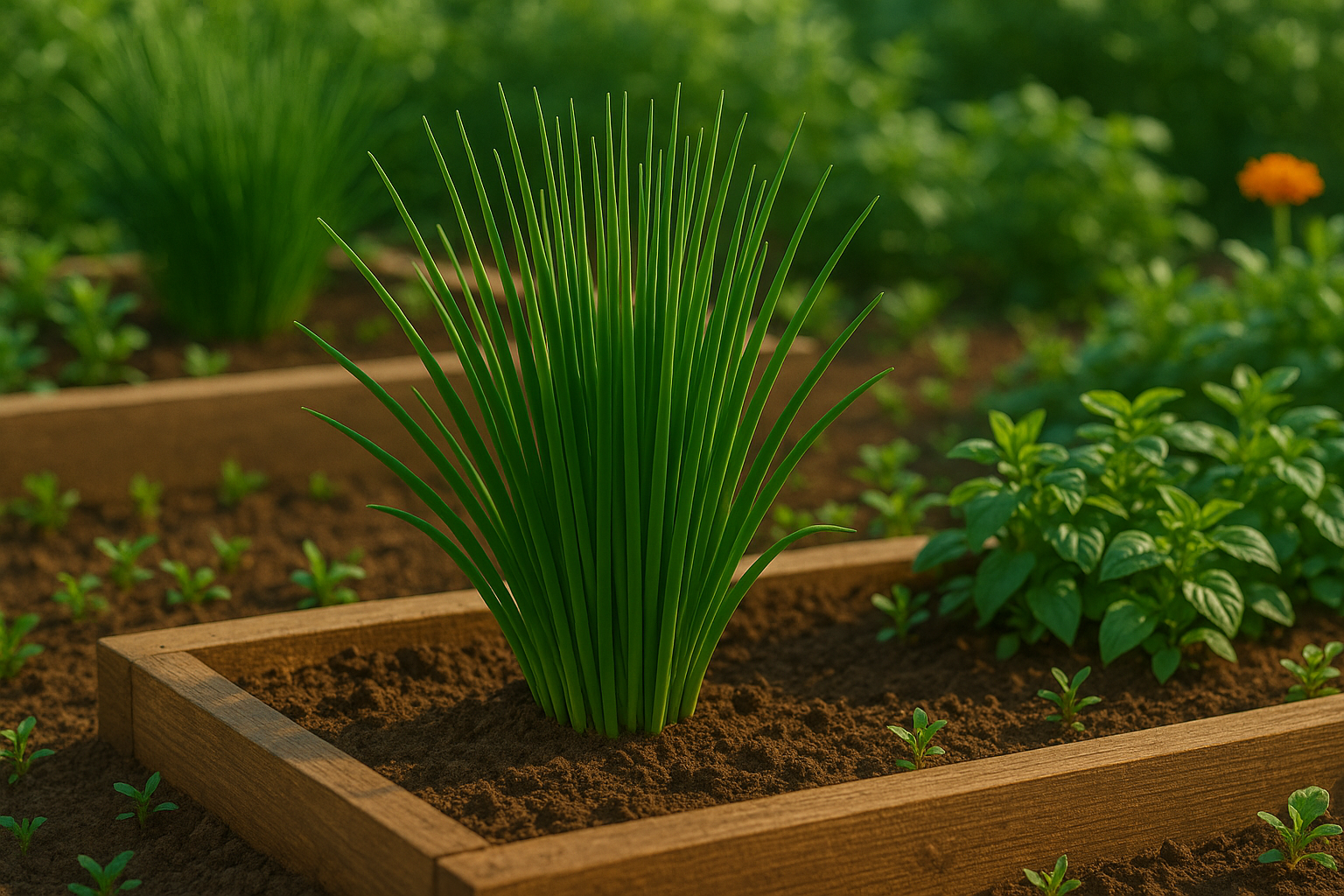Introduction
Chive pests can become a surprising headache, even for gardeners who rely on this hardy herb for dependable yields. Chives are cherished for their fresh, onion-like flavor and easy care, making them a favorite in kitchen gardens, window boxes, and raised beds alike. Although chives are known to repel some bugs with their strong scent, they’re not immune to trouble.
Aphids, onion flies, thrips, and even snails may see your healthy chives as their next meal. Left unchecked, these pests can stunt growth, yellow leaves, and reduce your harvest. That’s why it’s important to know what to watch for early in the season.
By learning to spot pest damage and treating issues quickly—like blasting aphids off with water, hand-picking snails, or planting chives alongside pest-fighting neighbors—gardeners can keep their herb patch thriving. Controlling pests not only protects your chive crop but also supports a more vibrant, productive garden overall.
In this post, we’ll cover the most common insects and critters that target chives, plus tried-and-true ways to stop them and keep your chives on your dinner plate instead of on a pest’s menu.
Why Chives Attract Pests
Chives are often praised for being a low-maintenance herb, but they’re not entirely immune to pest issues. The natural scent and sulfur compounds in chives, especially allicin, act as a natural deterrent for several garden pests like aphids and Japanese beetles.
However, while this aroma wards off certain insects, it can actually attract others such as onion flies and thrips, which are specially adapted to seek out Allium plants. Gardeners sometimes notice problems when chives are grown in overly moist soil or crowded together, as these conditions create a damp environment where fungal gnats and root-eating larvae thrive.
For example, if you water your chives excessively or plant them with little space for air circulation, you invite fungal growth and mildew, which in turn can attract sap-sucking insects looking for weak plants to attack.
Pest management remains crucial because even tough herbs like chives can become breeding grounds for unwanted insects if neglected, eventually impacting their yield and health. Regularly check your plants for damaged leaves or sticky residue, space out your chives to promote airflow, and avoid watering too frequently. These simple practices help you enjoy a robust chive harvest while minimizing pest trouble—proof that a bit of prevention makes even the hardiest herbs truly low maintenance.
Most Common Pests Affecting Chives
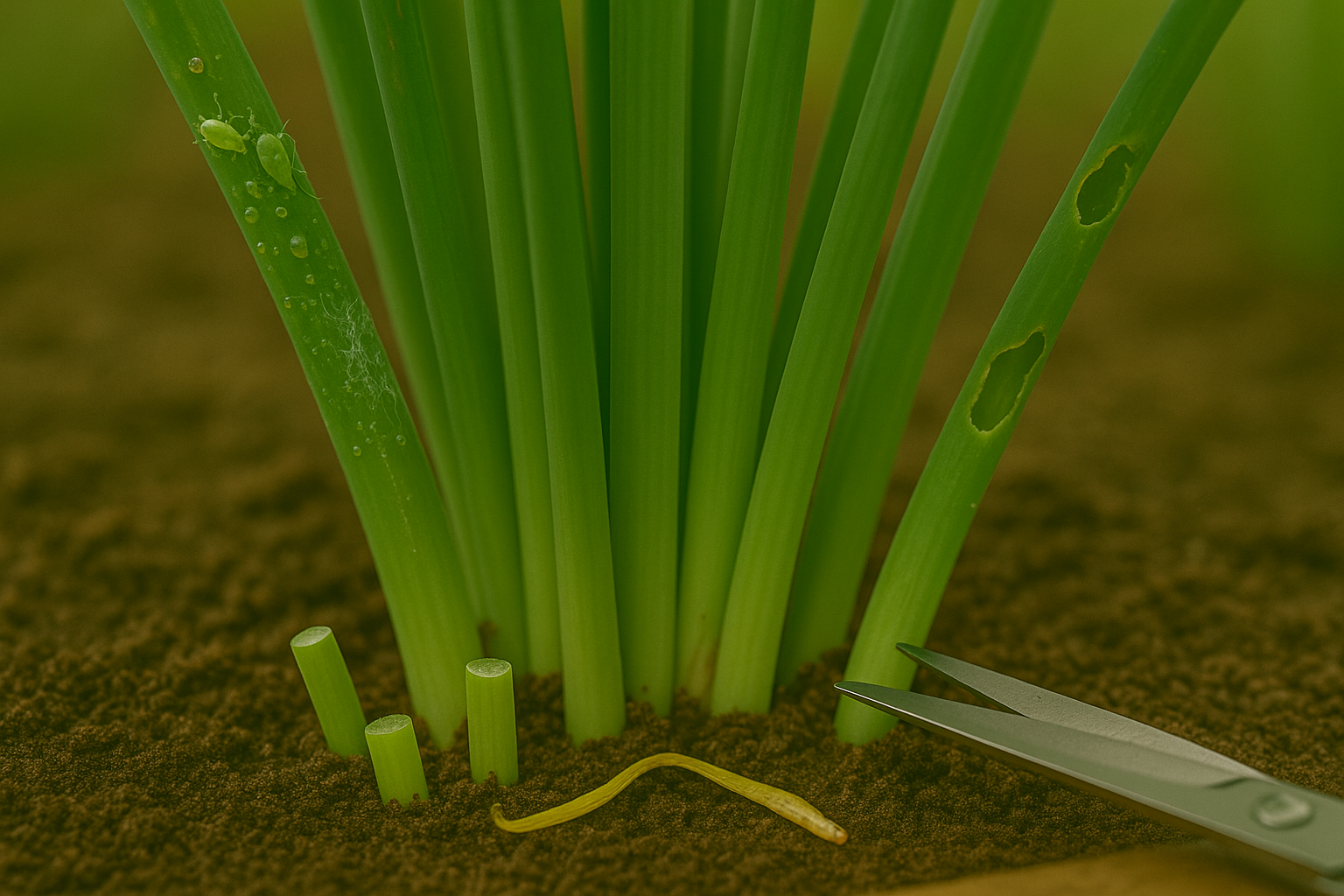
Chives are a garden favorite, but several pests can threaten their health and harvest.
Aphids are one of the most common culprits, often clustering on tender stems and leaves. They suck out plant juices, causing yellowing leaves and curled growth. You might spot sticky residue, known as honeydew, left behind.
Thrips are tiny, slender insects that feed by scraping plant surfaces, leading to silvery patches and distorted foliage.
Onion maggots target the roots and base of the chive plant, causing the whole plant to wilt and sometimes collapse altogether; if you dig nearby soil, you might see small white maggot larvae.
Spider mites are difficult to spot with the naked eye, but their presence leaves behind fine webbing on the undersides of leaves, along with speckled, yellowed, or dried-out foliage.
Leafminers tunnel through chive leaves, creating winding, white trails that are easy to spot and can reduce photosynthesis, slowing growth.
Slugs and snails are nocturnal pests that chew irregular holes in leaves, especially after rain or during cool, damp periods. They often leave behind a silvery slime trail as evidence.
The likelihood of each pest can depend on climate and season; for instance, aphids and spider mites are more prevalent in hot, dry weather, while slugs and snails come out during cool, moist conditions.
To spot and stop infestations early, check for damaged leaves, sticky or silvery residues, and any webbing or tunnels. If you find signs of pest activity, remove affected plant parts and use barriers or natural predators to keep populations under control.
Regular inspection—especially after changes in weather—can go a long way in protecting your chives from these common invaders.
How to Identify Pest Damage on Chives
Spotting pest damage on chives early can save your crop before problems get out of hand. Start by checking for the classic signs: wilting stems, small yellow or brown spots on leaves, or irregular holes that look as though something has been munching on the foliage. Make sure to inspect both the tops and undersides of leaves, since tiny insects like thrips and aphids may hide out of sight.
Compare these symptoms with plant issues like nutrient deficiency—which usually shows even yellowing across many leaves rather than patchy spots or chewing—and fungal infections, which often create fuzzy mold or uniform, water-soaked blotches.
Gently part the base of each plant and look for signs of larvae or tiny bugs on the soil surface, and don’t forget to check around the roots for any maggots or tunneling. Sometimes, gently pulling on the plant can reveal whether roots are weakened from pest damage.
Use a magnifying glass or even your phone’s camera set to macro mode for a closer look at any suspicious spots or pests. Keeping the area weed-free also helps, since many pests love hiding close by.
By doing a quick, close-up inspection at least once a week, you’ll catch pest problems early and avoid confusing them with other garden issues—giving your chives the best shot at staying healthy and productive.
Natural & Organic Methods to Control Pests
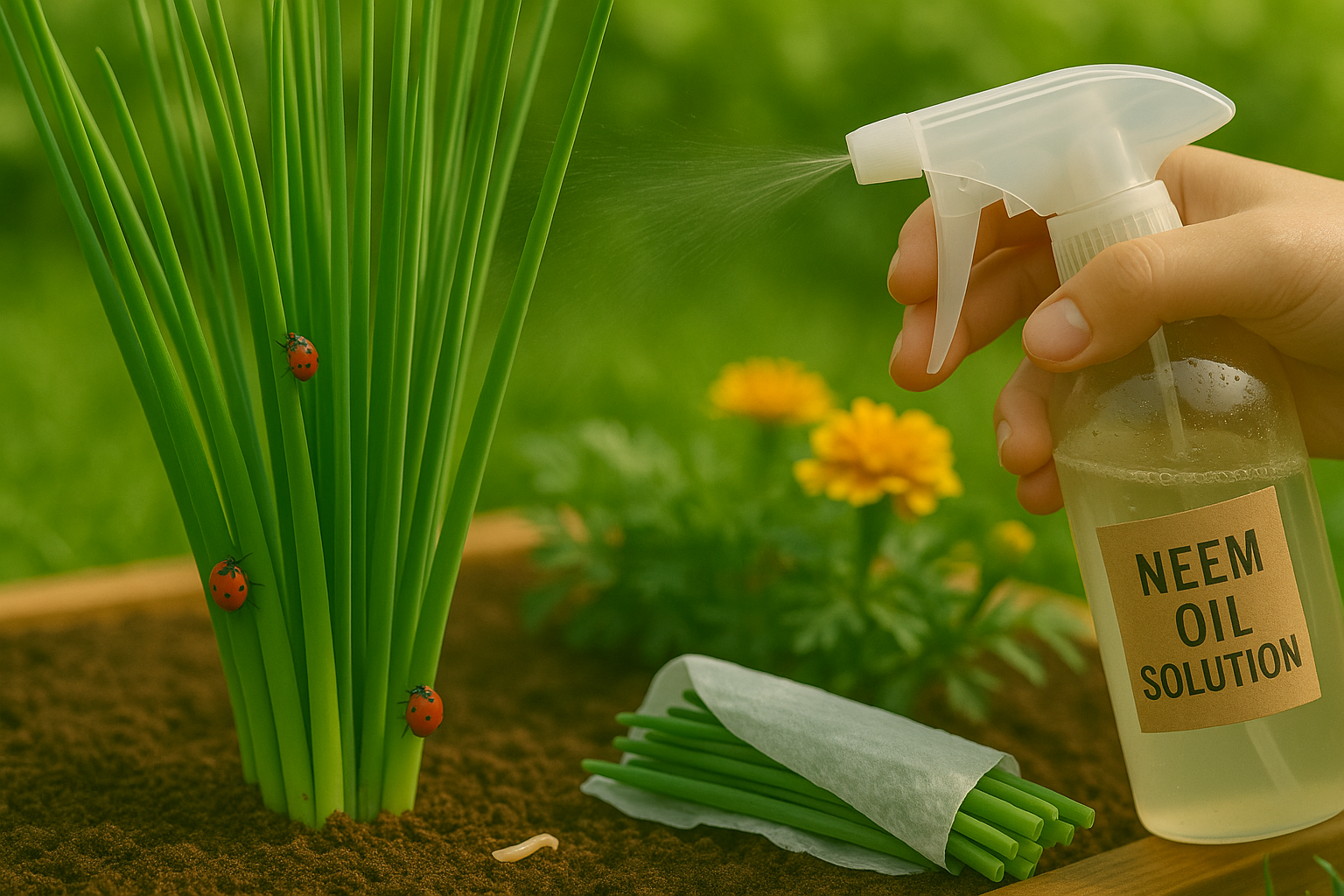
When it comes to managing garden pests without harsh chemicals, natural and organic methods offer safe, eco-friendly solutions that protect both your plants and the environment. A great place to start is with direct physical removal—hand-picking larger pests like beetles or caterpillars early in the morning when they’re sluggish is effective. You can simply drop them into a bucket of soapy water to dispose of them.
For smaller pests like aphids or spider mites, a strong burst of water from a hose often knocks them off plant stems and leaves, reducing their populations without causing harm.
Beyond hands-on approaches, you can introduce beneficial insects such as ladybugs, lacewings, or predatory mites. These natural predators help control common garden pests and maintain a healthy ecological balance.
Companion Planting
Companion planting is another smart strategy:
- Plant marigolds around vegetables to deter nematodes and aphids.
- Interplant basil with tomatoes to repel hornworms.
Safe Home Remedies
There are also easy home remedies to prepare and use:
- Neem oil acts as a natural insect repellent and disrupts pest life cycles. Mix a couple of teaspoons with water and a few drops of mild soap, then spray it on affected plants.
- Homemade garlic spray can ward off a variety of insects. Blend a few cloves of garlic with water, strain the mixture, and apply it to your plants with a spray bottle.
- Insecticidal soaps, either store-bought or homemade using pure castile soap and water, are gentle on plants but deadly to soft-bodied insects like aphids and whiteflies.
Consistency is key—repeat applications and close observation help ensure these methods work effectively. By combining these non-chemical approaches, gardeners can naturally control pests, safeguard pollinators, avoid chemical residues in their harvests, and foster a thriving, sustainable garden ecosystem.
Preventing Future Infestations
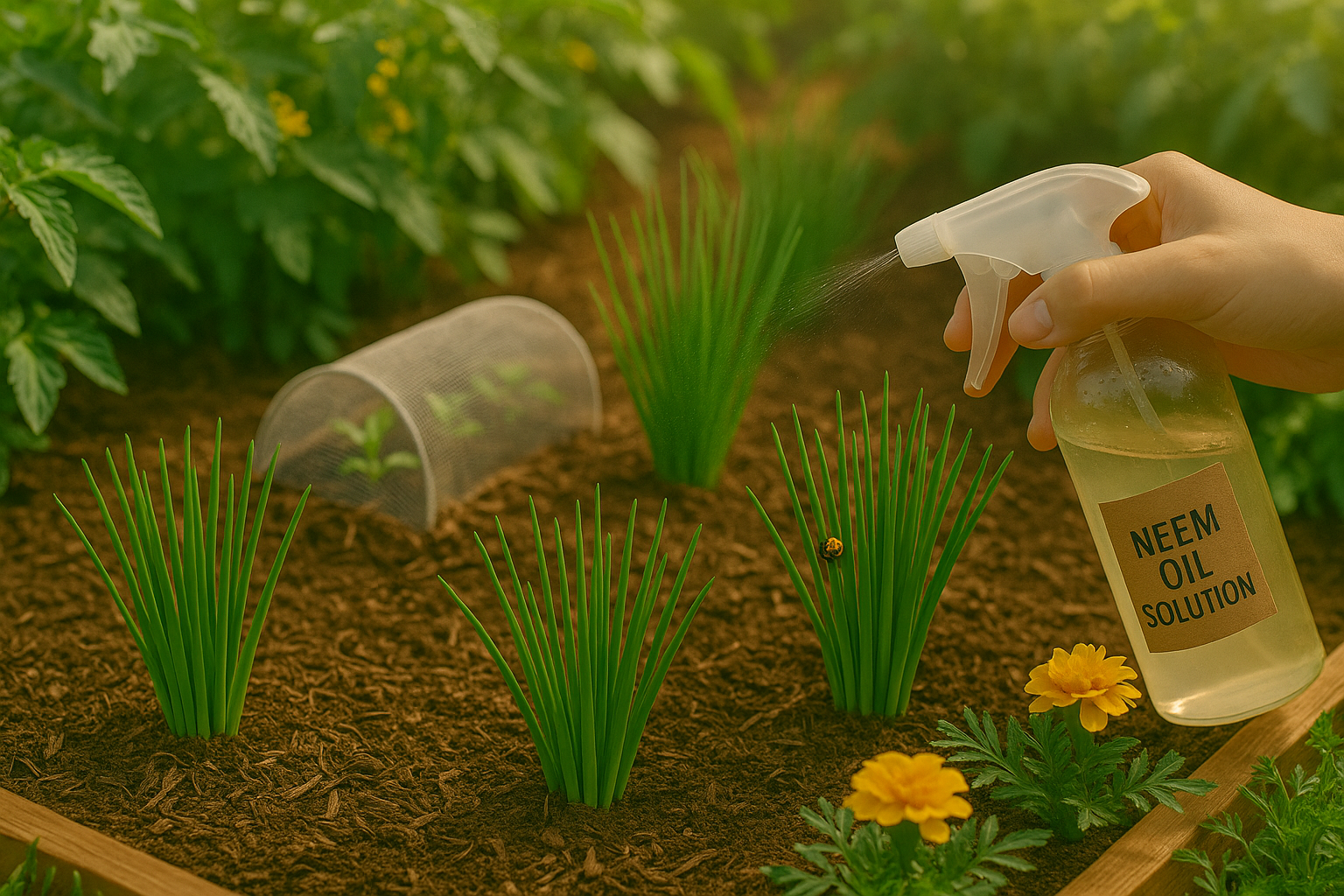
Preventing future infestations starts with thoughtful garden planning and daily habits that support plant health. Begin by spacing your plants properly to improve air circulation; this simple step helps foliage dry faster and makes it tougher for fungal spores, aphids, or fungal gnats to take hold.
Avoid overcrowding by thinning seedlings and following plant spacing guidelines, even if you’re tempted to squeeze in just one more tomato. Rotating your crops each season is another smart move—planting crops from different families in different spots each year breaks pest life cycles and reduces the buildup of soil-borne diseases.
It’s also crucial to maintain soil health. Add compost or well-rotted manure to enrich the soil, and avoid excessive nitrogen fertilizers, which can attract pests like aphids. Mulching is a double win: a 2-3 inch layer of organic mulch, such as straw or shredded leaves, helps regulate soil moisture, suppress weeds that compete with your crops, and keep soil-dwelling insects under control.
On top of these cultural practices, keep a close eye on your garden with regular monitoring—look under leaves for eggs or pests, check for sticky residue, and act early if you spot something unusual. Early detection is often the key to preventing a small problem from becoming an infestation.
For additional protection, consider using row covers or simple mesh barriers, especially when seedlings are young and most vulnerable. These physical barriers can block many common pests, giving your plants a strong head start.
Remember, a little daily observation combined with good gardening habits goes a long way in keeping pests at bay, so you can enjoy a lush and healthy harvest season after season.
When to Use Chemical Controls (and Safety Tips)
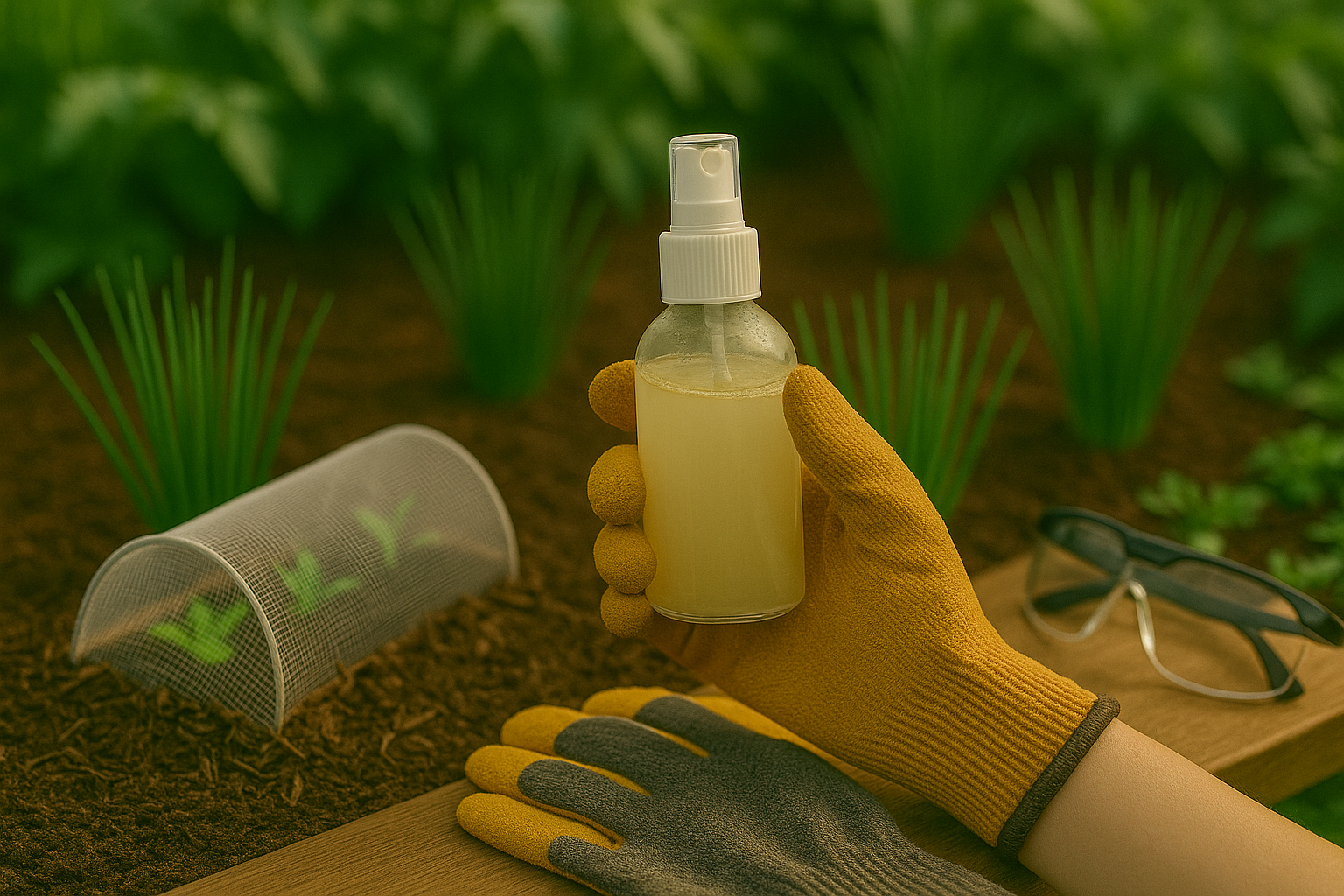
Sometimes, despite your best efforts with organic pest control—like handpicking, neem oil, or introducing ladybugs—stubborn pests can still threaten your edible herbs. If an infestation spirals out of control and starts visibly damaging your plants, or if common organic treatments consistently fail, it may be necessary to consider chemical controls as a last resort.
When choosing a pesticide, look for products specifically labeled as safe for use on edible herbs, and opt for the mildest option available, such as insecticidal soaps or pyrethrin-based sprays, which generally break down quickly and leave minimal residue. Always read labels carefully to ensure the product targets your specific pest, and apply only when and where needed—never blanket spray an entire garden.
For the safety of your household and helpful pollinators like bees, spray in the early evening when pollinators are less active and avoid treating flowers directly. Wear gloves and protective clothing, wash herbs thoroughly before consumption, and store chemicals out of reach of children and pets.
Remember, chemical controls should complement—not replace—overall good garden practices like regular monitoring and promoting healthy plant growth.
Conclusion & Quick FAQ
When managing pests on chives, start by regularly inspecting your plants, especially the undersides of leaves where bugs like aphids or thrips may hide. Remove any affected leaves promptly and wash the plant with a strong spray of water or a mild soapy solution to naturally dislodge pests. If you notice serious infestations, opt for organic treatments like neem oil—just follow the package directions and avoid spraying on very hot or sunny days.
Crop rotation and good garden hygiene make a big difference, so be sure to clear away debris where pests can overwinter. Mulching around chives may also help deter soil-borne pests. After any treatment, wait several days and wash chives well before eating; most organic sprays are safe, but always check the label for waiting periods.
Chives themselves can help repel certain bugs like carrot flies and aphids, making them a smart companion plant in your garden.
Quick FAQ
- Can you eat chives after pest control? Yes, just ensure the treatment is food-safe and the leaves are thoroughly rinsed.
- Do chives keep pests away? They offer some natural repellency, but no plant is foolproof—regular checks remain essential.
With these steps and a consistent watchful eye, you’ll quickly resolve issues and enjoy healthy, flavorful chives all season long.
